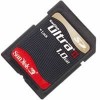SanDisk SDSDH-1024 Product Manual - Page 74
Commands
 |
UPC - 710348911073
View all SanDisk SDSDH-1024 manuals
Add to My Manuals
Save this manual to your list of manuals |
Page 74 highlights
Revision 2.2 Chapter 4 - SD Card Protocol Description SanDisk SD Card Product Manual 4.7.2 Read, Write and Erase Time-out Conditions The period after which a time-out condition for read/write/erase operations occurs is (card independent) either 100 times longer than the typical access times for the operations given in Table 4-6 or 100 ms (whichever is lower). The times after which a time-out condition for Write/Erase operations occur are (card independent) either 100 times longer than the typical program times for these operations given below or 250 ms (whichever is lower). A card will complete the command within this time period, or give up and return an error message. If the host does not get any response with the given time-out it should assume the card is not going to respond anymore and try to recover (e.g., reset the card, power cycle, reject). The typical access and program times are defined as shown in Table 4-6. Table 4-12 Typical Access and Program Time Operation Read Write Erase Definition The read access time is defined as the sum of the two times given by the CSD parameters TAAC and NSAC. These card parameters define the typical delay between the end bit of the read command and the start bit of the data block. This number is card-dependent and should be used by the host to calculate throughput and the maximal frequency for stream read. The R2W_FACTOR field in the CSD is used to calculate the typical block program time obtained by multiplying the read access time by this factor. It applies to all write/erase commands (e.g., SET (CLEAR)_WRITE_PROTECT, PROGRAM_CSD (CID) and the block write commands). The duration of an erase command will be (order of magnitude) the number of sectors to be erased multiplied by the block write delay. 4.8 Commands The following sections provide information about commands. 4.8.1 Command Types There are four kinds of commands defined to control the SD Card bus as shown in Table 413. Table 4-13 Command Definition Broadcast Command Broadcast w/Response Addressed point-to-point Addressed point-to-point data transfer Abbreviation bc bcr ac adtc Definition Applicable only if all the CMD lines are connected together in the host. If they are separate, each card will accept it separately in turn. Response from all cards simultaneously. Because there is not an open-drain mode in the SD Card, this command is used only if all the CMD lines are separate. The command will be accepted and responded to by every card separately. No data transfer on DAT. Data transfer on DAT. The command transmission always starts with the most significant bit (MSB). © 2004 SanDisk Corporation 4-30 12/08/04















